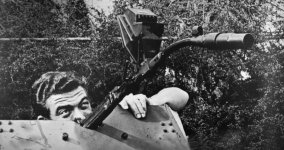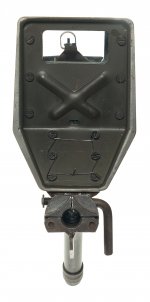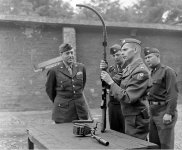jhv 41
Well-known member
I know forum policy is to not post active auctions but I believe this sold in Sept at RIA so it should be moot. Quite an interesting and rare option and bidding was slated for $65,000 - $95,000. Maybe I could bid on it if it ever comes up again if I win the lottery:



http://www.rockislandauction.com/viewitem/aid/62/lid/1469



http://www.rockislandauction.com/viewitem/aid/62/lid/1469
This is another example of a very rare WWII German assault rifle and Optical Sight that we are offering at auction. This is really a super rare, late war "StG 44" Assault Rifle. This assault rifle is rare on its own while this example has been fitted with an even rarer experimental "Krummlauf" curved barrel for use in armored vehicles. These were really an enigma to the U.S. troops with most believing they were a joke. However the earliest documented research in the use of curved barrels began in 1942, primarily for use in proof firing heavy anti-aircraft machine guns at short ranges. This later progressed to use with the K98 rifle which eventually piqued the interest of the German Armored Corps for use against dismounted infantry in and around tanks and armored vehicles. During this last development phase it was discovered that the best weapon for this use was the MP43/44 and StG assault rifles firing the shorter 7.82x33 Kurz round. They were intended to be mounted on armored vehicles or tanks via a ball-turret mount on top or the side of the vehicle through which the curved barrel was inserted and the ball turret allowed the firer to sweep the outside of the vehicles. The Krummlauf barrel arrangement used a special 1.5x optical sighting device with a 12 degree field of vision, mounted directly on top of the barrel that allowed the firer to sight down the barrel at an angle using the front sight. The last and final version (Variant V) which is this example of this barrel had two rows of five vent holes on the top rear portion of the barrel. This was intended to help bleed off excess gas to prevent bursting of the barrel as the bullet rounded the curve. This required a triangular shaped deflecting wedge, be mounted on top of the barrel directly below the optical sighting device to deflect the hot gases away from the view of the firer. It is estimated that approximately 20,000 units were ordered in total with only approximately 500 ever delivered with almost no examples being encountered on the collectors market today. This example has the longer 9 inch barrel with the 40 degree curve in the barrel. There are no manufacturers markings or model number on the barrel, however it is stamped "R1 70 . . 80" on top of the barrel. It is fitted with a K98 style front sight with a sheet metal cover. The assault rifle is a late war version that is stamped on the left side of the magazine well with the serial number "6506ai/45" and the "StG 44" marking on the left rear side of the receiver. The underside of the receiver in both the front and rear portion areas is stamped with "cos" indicating manufacture at the metal stamping works or Merzwerke, Gebr werks, in Merz Frankfurt. The left side of the trigger housing is stamped with only a single "WaA21" acceptance proof for the Wurttembergische Metallwarenfabrik A.G., who made the stamping for the trigger housing. The rear of the trigger housing has the matching serial number "6506AI". The front exposed section of the barrel has several “Eagle/37” Waffenamt and Eagle firing proof. It has an all blued finish with the bolt and bolt carrier assembly still in the white with the late war laminated butt stock and a set of late war black bakelite grips. As noted these rifles were the first true production assault rifle ever manufactured in the world, as they the intermediate length cartridge 7.92x33mm Kurz, which provided the German soldier with a greater (200-600 meters) effective range than the standard 9mm Luger cartridge in the MP40s with less weight than the standard 7.92 Mauser (8mm) cartridge. The MP44/StGs are a marvel of wartime expedient manufacturing techniques using a combination of stamped sheet metal parts, welded and pinned together with rough forgings, using a minimum of machined components. It is complete with one magazine and an original WWII leather sling.




